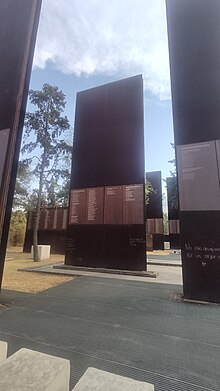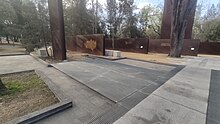Memorial to Victims of Violence in Mexico
The memorial is composed of 70 different-textured steel walls, and numerous reflectors projected light at different angles, some of which were originally underwater.
The first was the involvement of Calderón in the project as he started the Mexican drug war in 2006, while the second was its location at Campo Marte, a venue operated by the Secretariat of National Defense, whom acquaintances of the victims have accused of being complicit in the violence.
During his presidency, the low-intensity conflict led to casualties of an estimated 70,000 people[a] in collateral damage, with Calderón claiming that the majority of the fatalities were criminals.
[4] Isabel Miranda de Wallace, founder of the Alto al Secuestro association, asked Calderón for a location to place a memorial in 2010.
[7] The selected space was a 15,000 m2 (161,000 square feet)[8] field at Campo Marte, previously administered by the Secretariat of National Defense (SEDENA), in Chapultepec Park, Mexico City.
[8] On the final day of Calderón's presidency, Alejandro Poiré Romero, the Secretary of the Interior, symbolically inaugurated the memorial.
[13] Around 40 quotations from historical figures, including Cicero, Mahatma Gandhi, Martin Luther King Jr., and Carlos Fuentes, are engraved on the stelae.
[16] Jesús Tovar of El Siglo de Torreón described it as a "simple, humble, sober, integrated and different" work that plays with lights and nature to fill empty spaces.
[19] Nevertheless, the project received negative comments from human rights groups and society members, who criticized the monument's location and ambiguous dedication.
[20] In the book Museums and Sites of Persuasion, Benjamin Nienass and Alexandra Délano Alonso consider the monument to be "a façade of participation that is not so much intended to bring more democratic legitimacy or open debate to the space, but to simply relieve decision-makers of accountability".
[23] Architect Miquel Adrià [es] anticipated the monument to be forgotten due to the lack of social engagement as a "memorial only has value to the extent that it has a meaning".
Félix Hernández Guzmán of the Comité 68 group commented that regardless of the memorial's location, the organization has placed numerous plaques bearing the names of the Tlatelolco massacre victims there.
[26] By 2015, she said that the artwork's original purpose had been defeated because it failed to bring attention to the country's violence and the government had given the memorial no significance.
[25] In addition to Miranda de Wallace, Alejandro Martí of México SOS was present during the inauguration;[27] there, he commented that the memorial should symbolize a shared struggle to prevent any further tragedies.
Reyna Paz Avendaño from La Crónica de Hoy reported in 2022 that the site no longer has the original lighting, the water in the pond is stagnant, some walls have graffiti or show signs of shoddy work being done to remove it, the braille plates are damaged, and some panels erected in memory of the victims have been removed.


